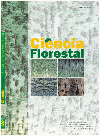
|
Ciência Florestal
Centro de Pesquisas Florestais - CEPEF, Departamento de Ciências Florestais - DCFL, Programa de Pós Graduação em Engenharia Florestal - PPGEF
ISSN: 0103-9954
EISSN: 0103-9954
Vol. 24, No. 1, 2014, pp. 47-58
|
 Bioline Code: cf14005
Bioline Code: cf14005
Full paper language: English
Document type: Research Article
Document available free of charge
|
|
|
Ciência Florestal, Vol. 24, No. 1, 2014, pp. 47-58
| pt |
LEVANTAMENTO FLORÍSTICO DO ESTRATO ARBÓREO DE TRÊS FRAGMENTOS DE FLORESTA CILIAR COMO SUBSÍDIO À RECOMPOSIÇÃO DA VEGETAÇÃO DO RIO CEDRO, MONTES CLAROS - MG
Oliveira Durães, Maria Clara; Pereira Sales, Nilza de Lima; D’Ângelo Neto, Santos & Auxiliadora Pereira Figueiredo, Maria
Resumo
Os objetivos deste estudo foram conhecer a composição florística de três fragmentos de floresta ciliar do
Rio Cedro, Montes Claros - MG e selecionar espécies para serem utilizadas na recomposição. Realizou-se o
levantamento florístico, análise de similaridade e a classificação sucessional. Foram amostrados 356 indivíduos
em três fragmentos, sendo: 99 no 1o, 117 no 2o e 140 no 3o com um total de 53 espécies, duas não identificadas,
46 gêneros e 22 famílias. O 1o Fragmento apresentou a maior riqueza florística: 28 espécies, seguida pelo 2o
com 26 e o 3o com 25. As famílias com maior número de indivíduos foram Fabaceae (111), Malvaceae (50),
Arecaceae (45) e Anacardiaceae (32). A Fabaceae foi a família com maior número de espécies representas. Das
análises, obteve-se um índice de similaridade de Sørensen para os Fragmentos: 1 e 2, 52,8%, 2 e 3, 40% e 1 e
3 33,3%. Os valores maiores de riquezas de espécies pioneiras e secundárias iniciais caracterizam uma fase de
transição da floresta pioneira, típica de estágio sucessional médio. Os fragmentos apresentam características
da floresta estacional decidual, encontrando-se perturbados. Para a recomposição da floresta ciliar propôs-se a
seleção de espécies de diferentes grupos ecológicos.
Palavras-chave
floresta ciliar; composição florística; conservação
|
| |
| en |
FLORISTIC SURVEY OF ARBOREAL STRATUM OF THREE FRAGMENTS OF RIPARIAN FOREST AS A SUBSIDY TO ‘RIO CEDRO’ VEGETATION RECOMPOSITION IN MONTES CLAROS - MG
Oliveira Durães, Maria Clara; Pereira Sales, Nilza de Lima; D’Ângelo Neto, Santos & Auxiliadora Pereira Figueiredo, Maria
Abstract
The objectives of this study were to know the floristic composition of three fragments of riparian forest from
Rio Cedro, Montes Claros, Minas Gerais state and select species to be used in its recomposition. It was done
a floristic survey, similarity analysis and sucessional classification of species. We sampled 356 individuals in
three fragments, and: 99 at the 1st one, 117 at the 2nd one and 140 at the 3rd one with a total of 53 species,
2 unidentified, 46 genera and 22 families. The majority floristic wealth was found at the 1st fragment:
28 species, then at the 2rd one with 26 last at the 3nd with 25. The families with the highest number of
individuals were Fabaceae (111), Malvaceae (50), Arecaceae (45), Anacardiaceae (32). The Fabaceae family
showed the greatest number of species represented. By the tests, Sorensen’s similarity rate was obtained for
the fragments: 1 and 2, 52.8%, 2 and 3, 40% and 1 and 3 33.3%. The greatest wealth of pioneering species
and secondary ones characterize an initial phase of transition from forest pioneering, typical of sucessional
medium probation and show characteristics of seasonal decidual forest. The fragments studied are disrupted.
In order to the recomposition of the riparian forest, a selection of species to be used in its recomposition and
the combination of different ecological groups are proposed.
Keywords
riparian forest; floristic composition; conservation
|
| |
© Copyright 2014 - Ciência Florestal
Alternative site location: http://cascavel.ufsm.br/revistas/ojs-2.2.2/index.php/cienciaflorestal/index
|
|
